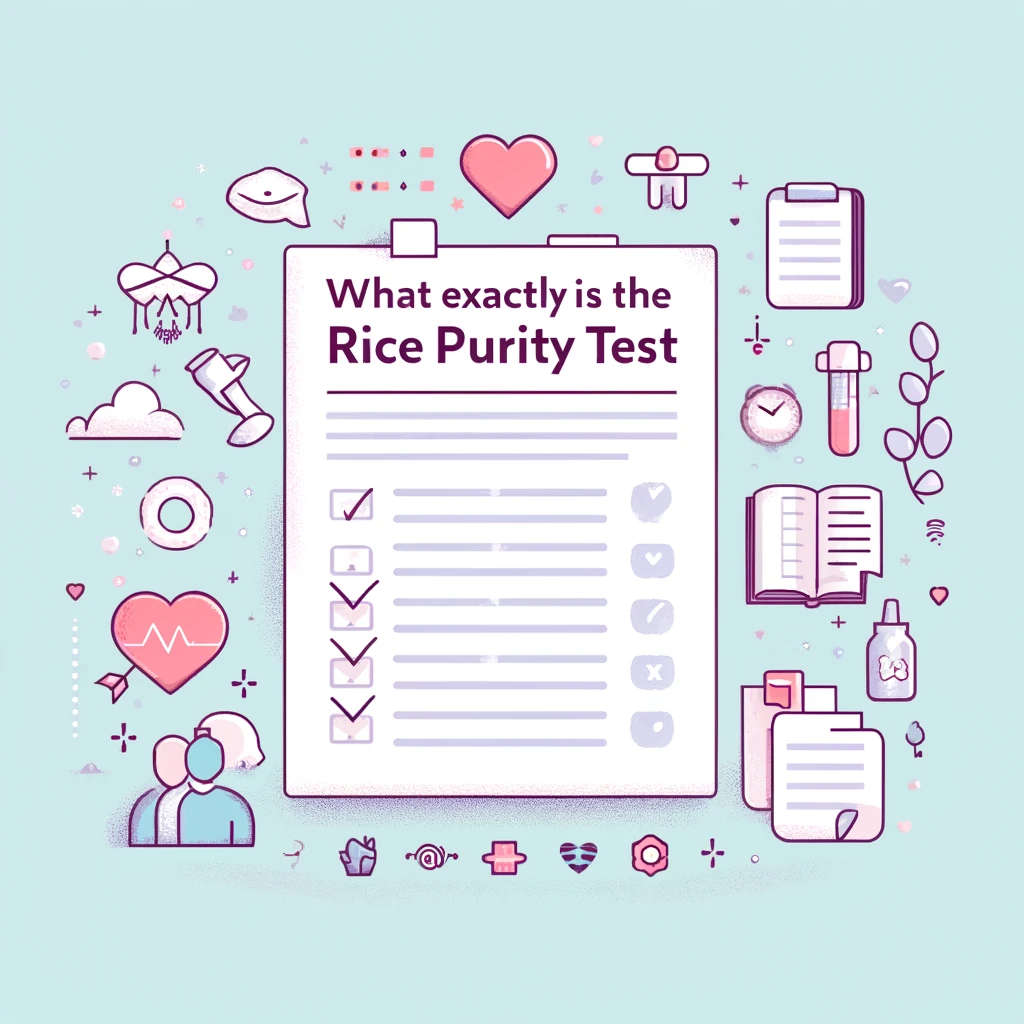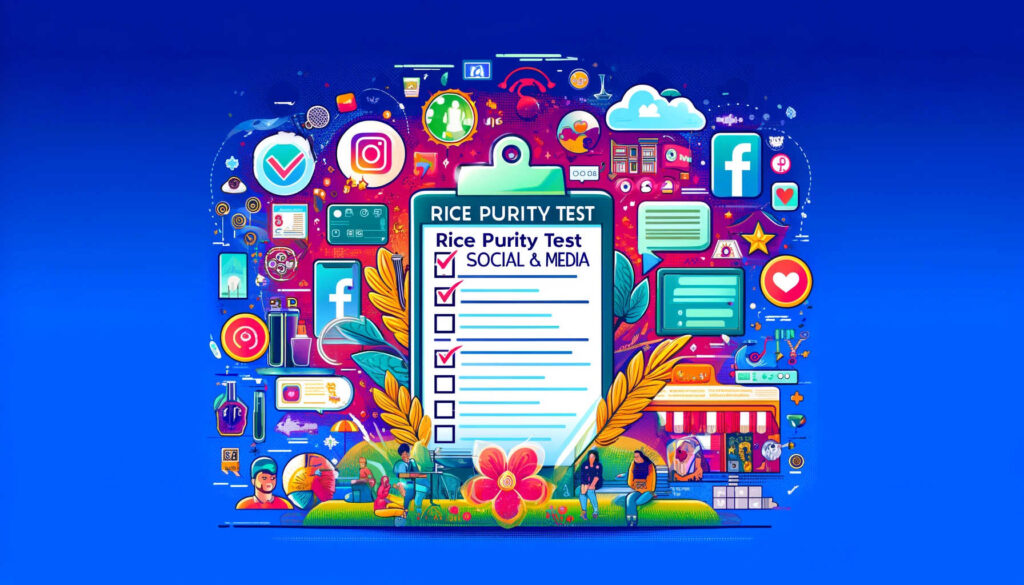Have you ever wondered why online quizzes and tests captivate millions of people worldwide? From personality quizzes to compatibility tests, these entertaining and sometimes insightful activities offer a fun way to learn more about ourselves. Among these quizzes, the Rice Purity Test stands out due to its unique blend of curiosity and nostalgia.
The Rice Purity Testing, first developed at Rice University in 1924, was initially designed as a way for students to bond and share their experiences in a light-hearted manner. Over time, it has evolved from a college tradition into a widely recognized online quiz that measures one’s “purity” based on a series of questions about life experiences.
In this blog post, we will explore the origins and evolution of the Rice Purity Test, delve into its purpose, and discuss its cultural impact. By the end, you’ll have a comprehensive understanding of what this test is all about and why it continues to intrigue people of all ages.
The History of the Rice Purity Test
Origin
The Rice Purity Test was created in 1924 at Rice University in Houston, Texas. It began as a voluntary survey for freshmen to gauge their experiences and promote bonding among new students. This early version of the test aimed to break the ice and encourage conversations about personal experiences in a fun and non-judgmental way.
Purpose
The original purpose of the Rice Purity Test was to serve as an icebreaker for incoming students. By answering a series of questions about various life experiences, students could find common ground and foster friendships. The test covered a wide range of activities, from innocent childhood memories to more adult-themed experiences, helping students open up about their lives.
Evolution
Over the decades, the Rice Purity Test has undergone significant changes. What started as a simple paper questionnaire has transformed into a popular online quiz accessible to anyone with an internet connection. The test’s content has also evolved to reflect changes in societal norms and behaviors. Today, the Rice Purity Test includes a mix of questions that span different aspects of life, such as:
- Relationships: Questions about romantic and platonic relationships.
- Behavior: Queries about social behaviors and habits.
- Legal Issues: Inquiries about interactions with law enforcement.
These changes have helped the test maintain its relevance and appeal, making it a fascinating tool for self-reflection and social interaction in the digital age.
What is the Rice Purity Test?
Description
The Rice Purity Test is a self-graded survey that assesses an individual’s level of innocence based on their life experiences.
Participants answer a series of 100 questions about various activities, ranging from the innocent to the more risqué.
Participants answer “Yes” or “No” to each question, and their final score reflects their “purity” level, with higher scores indicating fewer experiences and greater innocence.
The test is designed to be taken voluntarily and anonymously, making it a fun and introspective exercise.
The Rice Purity Test has evolved from a paper questionnaire to a popular online quiz, maintaining its appeal through its ability to spark conversations and self-reflection among individuals and groups.

Content
The Rice Purity Test consists of 100 questions, each pertaining to different life experiences. These questions cover a broad spectrum of activities, including:
- Relationships: Questions about romantic and sexual relationships.
- Behavior: Inquiries about social behaviors, such as partying or drinking.
- Legal Troubles: Questions regarding any interactions with law enforcement or legal issues.
Scoring System
The scoring system of the Rice Purity Test is straightforward. Each “Yes” answer indicates that the participant has experienced the activity in question, and each “No” answer means they have not. The final score is calculated by subtracting the number of “Yes” responses from 100, resulting in a score that ranges from 0 to 100. A higher score indicates a higher level of innocence or “purity,” while a lower score suggests a greater number of life experiences.
How to Take the Rice Purity Test
Availability
The Rice Purity Test can easily be found online with a quick search. Numerous websites host the test, making it accessible to anyone interested in taking it. Simply type “Rice Purity Test” into your preferred search engine, and you’ll find several versions available.
Process
Taking the Rice Purity Test is a simple process. Here’s what participants can expect:
- Find the Test: Locate the test on a website that hosts it.
- Start the Quiz: Click on the start button to begin the test.
- Answer Honestly: Go through each of the 100 questions, answering “Yes” or “No” based on your experiences.
- Submit Your Answers: After completing all the questions, submit your answers to receive your score.
Interpreting Results
Once you have your score, interpreting it is part of the fun. Here’s a general guide to understanding what your score might imply:
- 90-100: Highly pure, indicating fewer life experiences in the areas covered by the test.
- 70-89: Moderately pure, suggesting a balanced range of experiences.
- 50-69: Less pure, indicating more diverse life experiences.
- Below 50: Least pure, suggesting a high number of life experiences.
Remember, the Rice Purity Test is meant to be taken in good fun. It’s a light-hearted way to reflect on your life experiences and see how they compare to others. There’s no right or wrong score, and the results should not be taken too seriously.
The Popularity and Impact of the Rice Purity Test
Cultural Relevance
The Rice Purity Test has maintained its popularity over the decades due to its unique blend of curiosity, nostalgia, and social interaction. Originally a fun way for college students to bond and share their experiences, the test has become a cultural phenomenon that transcends generational gaps. Its continued relevance can be attributed to its ability to spark conversations about shared experiences and societal norms, making it a timeless activity for self-reflection and group bonding.
Social Media Influence
Social media has played a significant role in the resurgence of the Rice Purity Test among younger generations. Platforms like TikTok, Instagram, and Twitter have amplified its reach, with users sharing their scores and reactions online. This viral nature of social media allows the test to spread rapidly, creating trends and challenges that encourage more people to participate. The communal aspect of sharing scores and comparing experiences online has given the test a new life in the digital age.

Psychological Impact
The Psychological Appeal of the Rice Purity Test lies in the human desire for self-assessment and social comparison. People are naturally curious about how their experiences measure up to those of others. Taking the test and seeing one’s score can provide a sense of validation or self-awareness.
Additionally, the test can be a conversation starter, allowing individuals to discuss personal experiences in a safe and anonymous manner. However, it’s important to remember that the test is meant for fun and should not be taken too seriously, as it does not accurately define one’s character or worth.
Criticisms and Controversies
Privacy Concerns
One of the main criticisms of the Rice Purity Test is related to privacy issues. Since the test is often taken online, there is a risk of personal data being collected and misused by websites hosting the test. Participants should be cautious about the sites they use to ensure their data is not being tracked or shared without their consent. It’s advisable to use reputable websites and avoid entering any personal information beyond the answers to the test questions.
Accuracy and Relevance
The Rice Purity Test has faced scrutiny regarding its accuracy and relevance in modern times. Some critics argue that the questions are outdated and may not reflect the current social landscape. The experiences listed in the test can also vary widely in their significance, making it difficult to gauge true “purity” or innocence. As society evolves, so do the norms and behaviors that define it, and the test may not adequately capture these changes.
- Outdated Questions: Some questions may no longer be relevant to modern experiences.
- Varied Significance: The importance of different experiences can vary greatly among individuals.
- Evolving Norms: Social behaviors and norms change over time, which the test might not accurately reflect.
Potential for Misuse
Another concern is the potential for the Rice Purity Test to be misused for shaming or pressuring individuals. Scores can sometimes be used to judge or mock others, leading to feelings of embarrassment or inadequacy. It’s important to approach the test with a mindset of fun and self-reflection, rather than competition or judgment. Encouraging a positive and supportive environment can help mitigate these negative effects and ensure the test remains a light-hearted activity.
By considering these aspects, we can appreciate the Rice Purity Test for what it is—a nostalgic and entertaining quiz that offers a glimpse into our personal experiences and societal norms. As long as it is taken in the right spirit, it can continue to be a fun and insightful activity for people of all ages.

Conclusion
Summary
In this blog post, we’ve explored the Rice Purity Test in depth. We started with its origins at Rice University in 1924 and discussed its initial purpose as a bonding tool for college students.
We then defined what the Rice Purity Test is, outlined its content and scoring system, and provided a guide on how to take it. We examined the test’s cultural relevance, the influence of social media on its popularity, and the psychological aspects of why people are drawn to it. Finally, we addressed some criticisms and controversies, including privacy concerns, the test’s accuracy and relevance, and its potential for misuse.
Personal Reflection
Reflecting on the Rice Purity Test, I find it fascinating how a simple set of questions can spark so much introspection and conversation. It’s a reminder of how our experiences shape who we are and how we connect with others.
While it’s important to take the test with a grain of salt and not let it define us, it can still be a fun and enlightening activity. Personally, I see it as a nostalgic trip down memory lane and an opportunity to reflect on my own journey through life.
Additional Sections
Fun Facts
Here are some interesting trivia and fun facts about the Rice Purity Test:
- Historical Roots: The test was originally a paper questionnaire handed out to freshman students at Rice University.
- Global Reach: The online version of the test has been taken by millions of people worldwide.
- Pop Culture: The test has been mentioned in various TV shows, movies, and online forums, highlighting its enduring appeal.
Related Tests
If you enjoyed the Rice Purity Test, you might also find these similar quizzes interesting:
- The Myers-Briggs Type Indicator (MBTI): A popular personality test that categorizes people into 16 different personality types.
- The Big Five Personality Test: Assesses individuals based on five major personality traits: openness, conscientiousness, extraversion, agreeableness, and neuroticism.
- The Enneagram Test: Identifies nine different personality types and explores the interrelationships between them.
- Love Languages Quiz: Helps you understand your preferred way of giving and receiving love.


